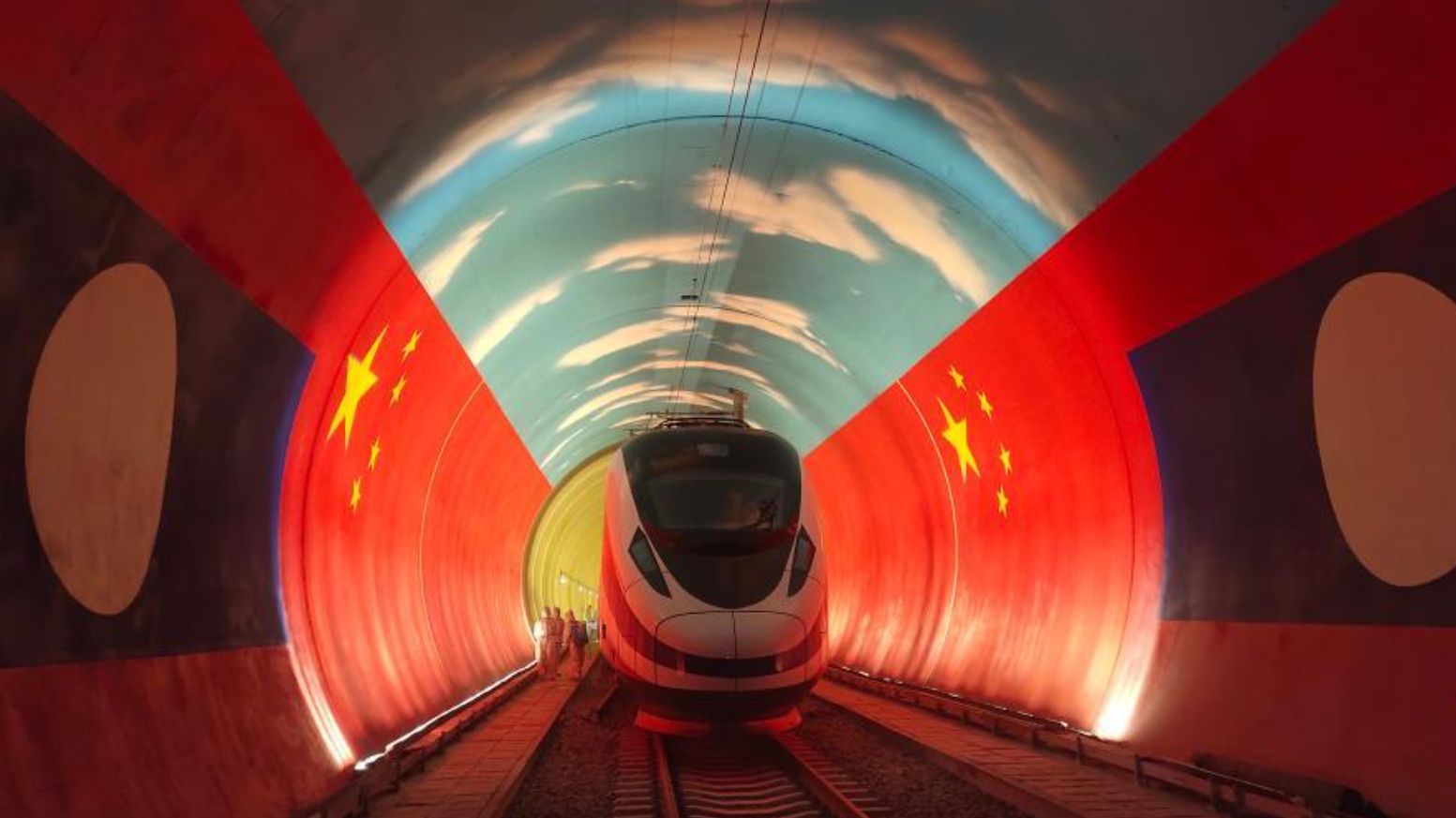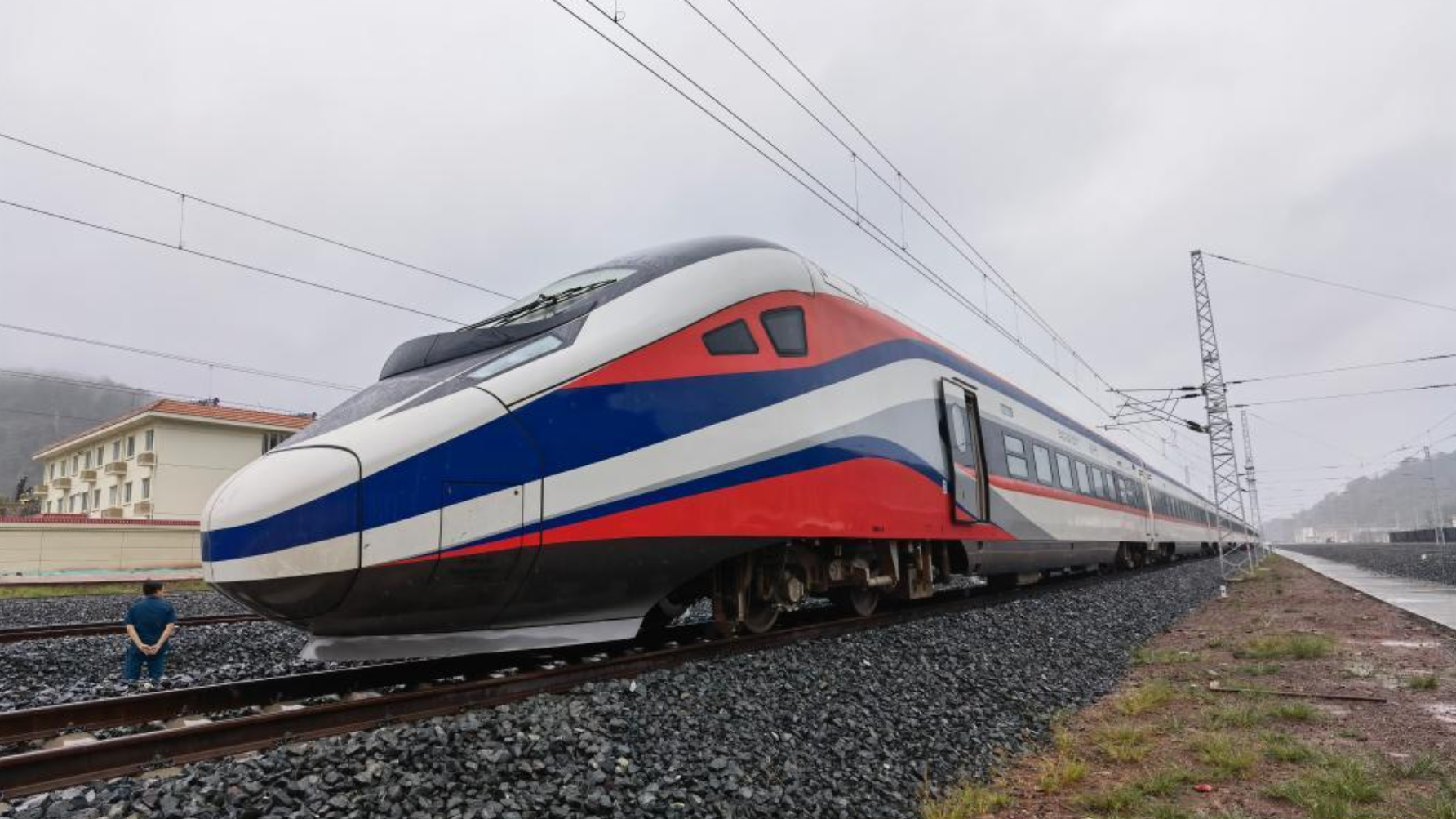
The Lane Xang EMU train passes by the China-Laos borderline inside a tunnel, October 15, 2021. /Xinhua
The Lane Xang EMU train passes by the China-Laos borderline inside a tunnel, October 15, 2021. /Xinhua
The recently finished China-Laos Railway, coming on the 60th anniversary of diplomatic ties between China and Laos, will boost economic links between China and Southeast Asia as an important part of the trans-Asian railway network, experts say.
Stretching from Kunming in southwest China's Yunnan Province to the capital of Laos, Vientiane, the over-1,000-kilometer electrified passenger and cargo railway was completed in October and will open to traffic in early December.
With a designed speed of 160 kilometers per hour, the travel time from Vientiane to the China-Laos border will be shortened from two days to three hours, and the journey to Kunming can be done overnight, according to Xinhua.
"What we are building is not only a railway, but also it represents the standards of 'made in China' and the inheritance of China-Laos friendship," said Wang Gengjie, general manager of China Railway's Kunming bureau, a contractor of the China-Laos Railway.
It was the first international railway to be mainly funded and constructed by China and directly connected with the Chinese railway network after the proposal of the Belt and Road Initiative in 2013.
"The China-Laos railway is a landmark achievement of dovetailing the Belt and Road Initiative and Laos' strategy to convert itself from a landlocked country to a land-linked hub," Foreign Ministry spokesperson Zhao Lijian said at a regular press conference in October.
The railway "will effectively improve infrastructure and connectivity in Laos and the region to boost sustainable economic development," Zhao added.
The railway will help promote economic development as well as people's livelihoods in underdeveloped Laos, and is expected to boost connectivity within the Association of Southeast Asian Nations (ASEAN), according to Wang Yiwei, director of the Institute of International Affairs at Renmin University of China.
"It will become a demonstration project of the Belt and Road Initiative and the relationship between China and neighboring countries," said Wang.

The Lane Xang EMU train arrives at the northern Laos' border town of Boten, after passing by the China-Laos borderline, October 15, 2021. /Xinhua
The Lane Xang EMU train arrives at the northern Laos' border town of Boten, after passing by the China-Laos borderline, October 15, 2021. /Xinhua
China-ASEAN economic connection
The China-Laos Railway will help connect China with ASEAN, as the trans-Asian railway network starts from the China-Laos Railway and extends to Thailand and Singapore, analysts say.
The recent crisis in global supply chains may prompt China and ASEAN members to explore the use of railways to avoid possible shipping crises in the future, according to Chen Bo, a professor at Huazhong University of Science and Technology.
If the completion of the China-Laos Railway leads to a successful connection of the railway system from China to Singapore, it will help diversify risks, said Chen.
"Once the ports on the Chinese mainland are blocked, there is an alternative choice to go to Singapore by the trans-Asian railway network or ship from ports like Thailand to the U.S.," said Chen.
But Chen also pointed out that the China-Laos Railway's role in promoting China-ASEAN economic and trade cooperation is temporarily limited, given that Laos is neither the economic core of ASEAN nor a distribution center for resources in Southeast Asia.
The key lies in whether the China-Laos Railway can extend to the entire Indochina Peninsula in the future, said Li Mingjiang, associate professor at the S. Rajaratnam School of International Studies, Nanyang Technological University in Singapore.
"Only in this way, will it have a great influence on China-ASEAN cooperation in sectors such as trade, investment and industrial chain," said Li.
Foreign trade between China and ASEAN soared by 30 percent year on year to about $703 billion in the first 10 months of 2021, accounting for 14.4 percent of China's total exports and imports during the period, according to the General Administration of Customs.
Affected by the COVID-19 pandemic, construction on the project faced many challenges such as disrupted transportation, difficulties in returning to work, and a tight supply of materials, according to the general manager of China Railway's Kunming bureau.
The completion of the China-Laos Railway as scheduled shows that China is committed to strengthening cooperation with ASEAN, said Chen. "China's commitment to the Belt and Road Initiative and the economic integration of Southeast Asia is very serious … It hasn't been terminated or reversed because of the COVID-19 pandemic or trade war."

